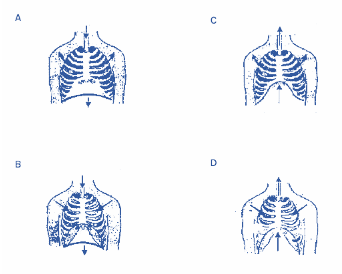
Exhalation is the process of expulsion of air through the respiratory tract. Which of the figures illustrate the process of respiration?


Answer
489k+ views
1 likes
Hint: The expulsion of air out of the lungs and airways to the surrounding environment is known as exhalation. Exhalation is important to move the carbon dioxide rich air outside the body. This process requires the movement of lungs and intercostal muscles, the diaphragm and the rib cage.
Complete answer:
Exhalation process is by which the carbon dioxide rich air is expelled out of the body. This takes place by the movement of lungs, the diaphragm, and the rib cage. Internal intercostal muscles play an important role in the contraction and relaxation of the rib cage to bring about the process.
The thoracic cavity has a little negative pressure that helps to keep the lungs open. Inhalation occurs with the contraction of diaphragm and thoracic cavity, that leads to expansion of the rib cage. While the process of exhalation involves relaxation of intercostal muscles and the diaphragm moves high up in the thoracic cavity.
Option (A) shows the diaphragm in a contracted position and the inside arrow through the windpipe or trachea shows inward movement of air. However outward arrows from the ribcage depict inflation of the structure indicating movement of air from outside to inside the body. It depicts the process of inhalation.
Option (B) shows the diaphragm in a contracted position and the inside arrows show movement of air from outside to inside the body. However inward arrows towards the rib cage indicate that the structure is in its original position. This process is not exhalation.
Option (C) shows the diaphragm to be up in the thoracic cavity. Outward arrows from the trachea or windpipe indicate air movement from inside of the body to outside. However, the rib cage is in an inflated position. This does not depict exhalation.
Option (D) shows the diaphragm to be up in the thoracic cavity. Outward arrows from the trachea or windpipe indicate air movement from inside of the body to outside. The rib cage is also in its original position. This depicts the process of exhalation.
So, the correct answer is option A.
Note: Exhalation is the process by which air moves from inside the body to outside. This is achieved by movement of internal intercostal muscles, diaphragm and the rib cage. The exhaled air is full of carbon dioxide gas. Exhalation takes place in rhythm with inhalation or breathing in oxygen rich air into the body. Exhalation and inhalation together constitute the respiratory cycle of an organism.
Complete answer:
Exhalation process is by which the carbon dioxide rich air is expelled out of the body. This takes place by the movement of lungs, the diaphragm, and the rib cage. Internal intercostal muscles play an important role in the contraction and relaxation of the rib cage to bring about the process.
The thoracic cavity has a little negative pressure that helps to keep the lungs open. Inhalation occurs with the contraction of diaphragm and thoracic cavity, that leads to expansion of the rib cage. While the process of exhalation involves relaxation of intercostal muscles and the diaphragm moves high up in the thoracic cavity.
Option (A) shows the diaphragm in a contracted position and the inside arrow through the windpipe or trachea shows inward movement of air. However outward arrows from the ribcage depict inflation of the structure indicating movement of air from outside to inside the body. It depicts the process of inhalation.
Option (B) shows the diaphragm in a contracted position and the inside arrows show movement of air from outside to inside the body. However inward arrows towards the rib cage indicate that the structure is in its original position. This process is not exhalation.
Option (C) shows the diaphragm to be up in the thoracic cavity. Outward arrows from the trachea or windpipe indicate air movement from inside of the body to outside. However, the rib cage is in an inflated position. This does not depict exhalation.
Option (D) shows the diaphragm to be up in the thoracic cavity. Outward arrows from the trachea or windpipe indicate air movement from inside of the body to outside. The rib cage is also in its original position. This depicts the process of exhalation.
So, the correct answer is option A.
Note: Exhalation is the process by which air moves from inside the body to outside. This is achieved by movement of internal intercostal muscles, diaphragm and the rib cage. The exhaled air is full of carbon dioxide gas. Exhalation takes place in rhythm with inhalation or breathing in oxygen rich air into the body. Exhalation and inhalation together constitute the respiratory cycle of an organism.
Recently Updated Pages
Master Class 9 General Knowledge: Engaging Questions & Answers for Success

Master Class 9 English: Engaging Questions & Answers for Success

Master Class 9 Science: Engaging Questions & Answers for Success

Master Class 9 Social Science: Engaging Questions & Answers for Success

Master Class 9 Maths: Engaging Questions & Answers for Success

Class 9 Question and Answer - Your Ultimate Solutions Guide

Trending doubts
Give 10 examples of unisexual and bisexual flowers

Draw a labelled sketch of the human eye class 12 physics CBSE

Differentiate between homogeneous and heterogeneous class 12 chemistry CBSE

Differentiate between insitu conservation and exsitu class 12 biology CBSE

What are the major means of transport Explain each class 12 social science CBSE

Why is the cell called the structural and functional class 12 biology CBSE




